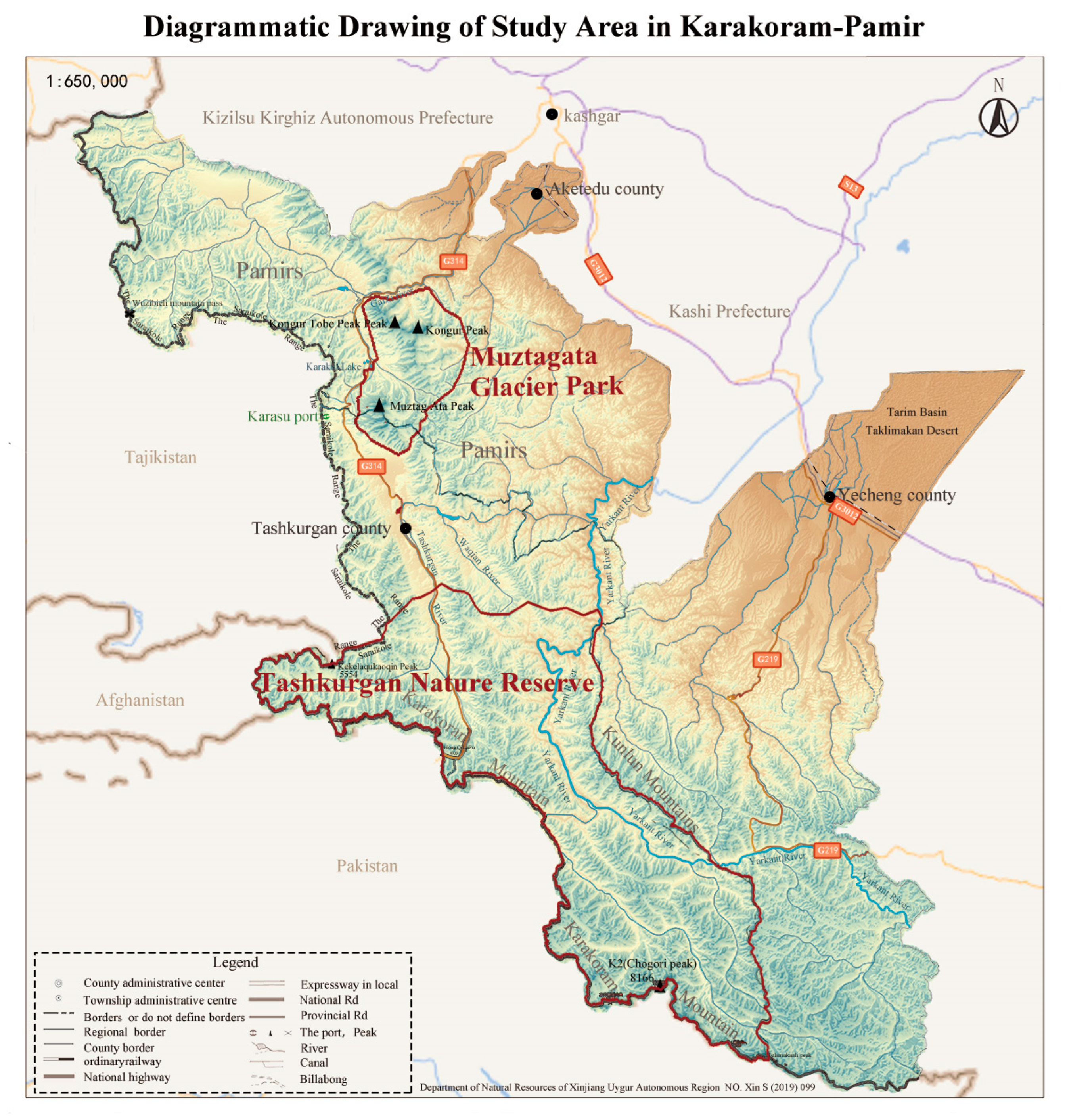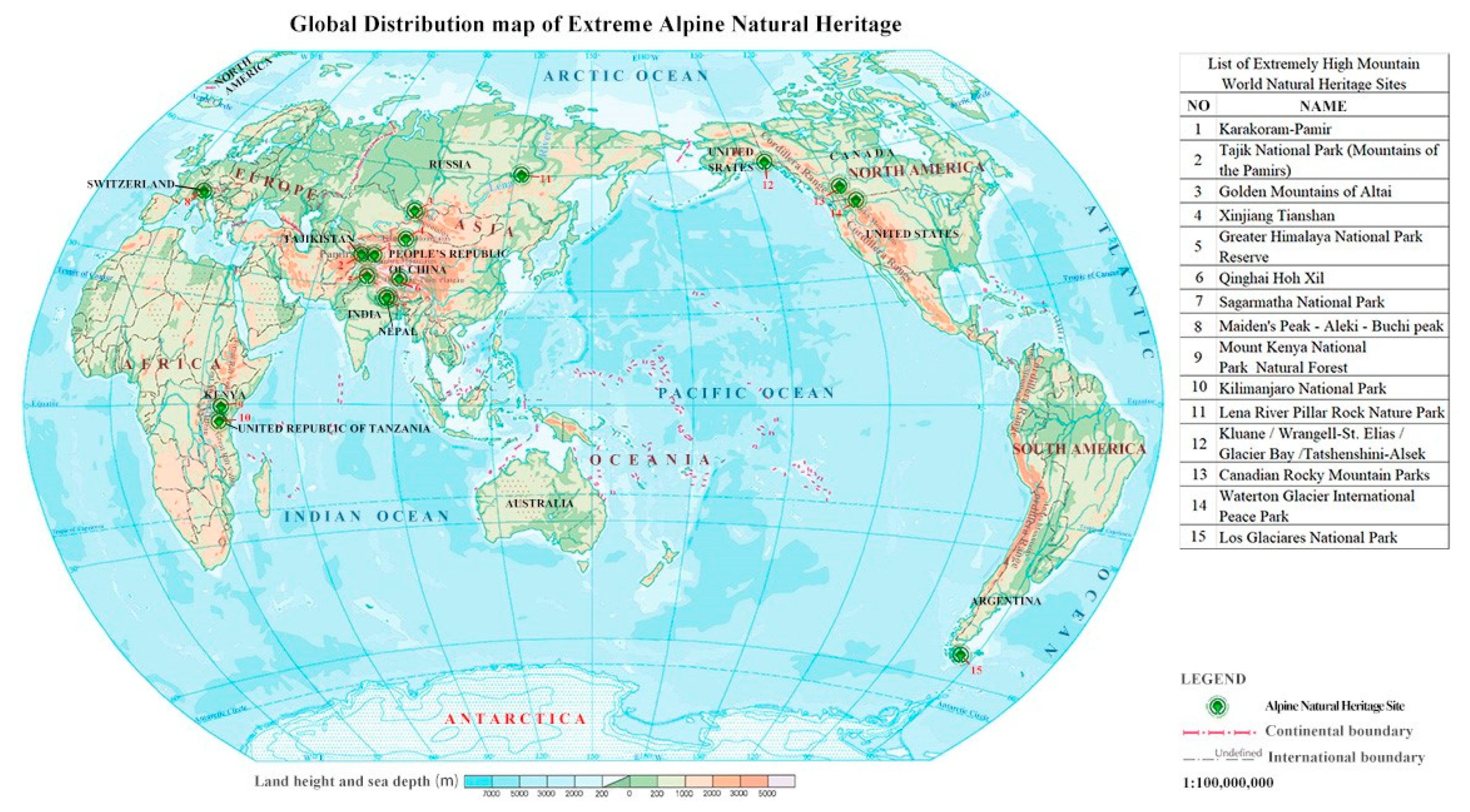OUV Analysis and Global Comparative Study of Karakoram-Pamir World Natural Heritage Potential Area
Abstract
:1. Introduction
2. Overview of the Study Area and Study Methods
2.1. The Study Area
2.2. Study Methods
2.2.1. Field Inquiry Method
2.2.2. Comprehensive Analysis Method
2.2.3. Expert Scoring Method
3. Natural Heritage Value
3.1. Aesthetic Value
3.2. Geological Value
3.3. Bioecological Value
4. Comparative Analysis of Heritage Value
4.1. Comparison with the Mountain Heritage Listed in the World Natural Heritage List
4.2. Aesthetic Value Comparison
4.3. Comparison of Geological Values
4.4. Comparison of Bioecological Values
5. Conclusions
6. Discussion
Author Contributions
Funding
Institutional Review Board Statement
Informed Consent Statement
Data Availability Statement
Conflicts of Interest
References
- UNESCO. Convention Concerning the Protection of the World Cultural and Natural Heritage; CENTRE WH: Paris, France, 1972. [Google Scholar]
- Wei, X.C.Z.; Chen, Z. Natural Reserve System in China from a Perspective of World Natural Heritage. J. West China For. Sci. 2021, 50, 180–184. [Google Scholar]
- UNESCO. Operational Guidelines for the Implementation of the World Heritage Convention; CENTRE WH: Paris, France, 2019. [Google Scholar]
- Cunha, S.F. Perestroika to Parkland: The Evolution of Land Protection in the Pamir Mountains of Tajikistan. Ann. Assoc. Am. Geogr. 2017, 107, 465–479. [Google Scholar] [CrossRef]
- Yu, H.; Deng, W.; Jia, J. Research on the Resources, Value and Protection of Qinghai Hoh Xil World Heritage Site. Chin. Landsc. Archit. 2018, 34, 106–111. [Google Scholar]
- Kim, S.J. Geographical and Environmental Features of the Canadian Rockies(Skyline, Lake O’Hara and Robson). J. Assoc. Korean Photo-Geogr. 2016, 26, 1–13. [Google Scholar]
- Yang, Z.; Zhang, X.; Di, F.; Wall, G.; Liu, X.; Shao, R. Natural heritage values and comparative analyses of Kanas, China. J. Arid Land 2010, 2, 197–206. [Google Scholar]
- Yang, S.; Jiang, J.; Yan, P. Eco-geographic distribution of rare and endangered plants and endemism in the Pamirs Region of China. J. Arid Land Resour. Environ. 2018, 32, 115–120. [Google Scholar]
- Centre, W.H. Karakorum-Pamir. Available online: http://whc.unesco.org/en/tentativelists/5535/ (accessed on 8 August 2021).
- Guodong, L. Tashkurgan Wildlife Reserve was established. For. Xinjiang 1984, 5, 26. [Google Scholar]
- Cheng, Q. Survey and Analysis of Wild Animal Resources in Xinjiang Taxkorgan Wildlife Nature Reserve. For. Resour. Manag. 2021, 3, 145–148. [Google Scholar]
- National Forestry and Grassland Administration, National Park Administration. Pamir Plateau Wetland Nature Reserve: Green Dress Beautiful Plateau. Available online: http://www.forestry.gov.cn/main/5536/20190705/171816754515616.html (accessed on 6 July 2021).
- Shangguan, D.H.; Liu, S.Y.; Ding, Y.J.; Ding, L.F.; Shen, Y.P.; Zhang, S.Q.; Lu, A.X.; Li, G.; Cai, D.H.; Zhang, Y. Monitoring Glacier Changes and Inventory of Glaciers in Muztag Ata-Kongur Tagh, East Pamir, China Using ASTER Data. J. Glaciol. Geocryol. 2005, 3, 344–351. [Google Scholar]
- International Union for Conservation of Nature, Red List of Threatened Species. Available online: https://www.iucnredlist.org/ (accessed on 6 July 2021).
- Wang, Z.; Yang, Z.; Shi, H.; Han, F.; Liu, Q.; Qi, J.; Lu, Y. Ecosystem Health Assessment of World Natural Heritage Sites Based on Remote Sensing and Field Sampling Verification: Bayanbulak as Case Study. Sustainability 2020, 12, 2610. [Google Scholar] [CrossRef] [Green Version]
- Agrawal, S.; Jain, A. Physical Modelling of Nanda Devi National Park, a Natural World Heritage Site, from GIS Data. Cartographica 2022, 57, 179–190. [Google Scholar] [CrossRef]
- Zhang, Q. Uplift and Environmental Changes of the Tibetan Plateau. Geoj. Libr. 2000, 57, 19–45. [Google Scholar]
- Yeong Bae Seong Lao, C.Y.; Robert, C. Finkel, Lindsay Schoenbohm., Dynamic Change of Landscape Spatial Pattern in Karakul Lake Region in Xinjiang. Chin. Agric. Sci. Bull. 2009, 103, 227–250. [Google Scholar]
- Kuerban, A.; Chu, X.; Aimaiti, Y. Dynamic Change of Landscape Spatial Pattern in Karakul Lake Region in Xinjiang. Chin. Agric. Sci. Bull. 2016, 32, 78–84. [Google Scholar]
- Liu Zongxiang, S.Z. Resources and Distribution of Glaciers on the Tibetan Plateau. Resour. Sci. 2000, 5, 49–52. [Google Scholar]
- ZhangXiangsong, Recent variations of the Insukati Glacier and adjacent glaciers in the Karakoram Mountains. J. Glaciol. Geocryol. 1980, 3, 12–16.
- Jianping, W. Geological features and tectonic significance of melange zone in the Taxkorgan area, West Kunlun. Geol. Bull. China 2008, 27, 2057–2066. [Google Scholar]
- Jiang Yaohui, R.G. New advances in granite research in the West Kunlun orogenic belt. Volcanol. Miner. Resour. 2000, 1, 61. [Google Scholar]
- Ding Daogui, L.Y. Collision structures in Pamir region and reformation of Tarim Basin. Oil Gas Geol. 2005, 26, 57–63, 77. [Google Scholar]
- Huang Dawei, L.Y. The Pamir Plateau A rare wonder of the world. In Proceedings of the 28th Annual Meeting of Tourism Geology and Geopark Research Branch of Chinese Geological Society and Seminar on Construction and Tourism Development of Guizhou Weaving Cave National Geopark, Beijing, China, 1 August 2013; p. 8. [Google Scholar]
- Liang Na, A.N. Tuerxunnayi Reyimu, Comparative Analysis of Floristic Phytogeography of Seed Plants Between Pamirs Plateau of Xinjiang and Tajikistan. Xinjiang Agric. Sci. 2015, 52, 1906–1916. [Google Scholar]
- McCarthy, T.; Breitenmoser, U.; Breitenmoser-Wrsten, C. Another flagship species was pushed to the brink of extinction. People Biosph. 2008, 6, 1. [Google Scholar]
- Zuojian, F. On the Status And Conservation of The Wild Animal Resources In The Karakorum-Kunlun Mountains Region, China. J. Nat. Resour. 1990, 4, 343–353. [Google Scholar]
- Fu, B.; Liu, G.; Chen, L.; Ma, K.; Li, J. Scheme of ecological regionalization in China. Acta Ecol. Sin. 2001, 21, 1–6. [Google Scholar]
- Xu, X.L.; Yang, Z.P.; Saiken, A.; Shao, R.; Liu, X.Y. Natural Heritage value of Xinjiang Tianshan and global comparative analysis. J. Mt. Sci. 2012, 9, 262–273. [Google Scholar] [CrossRef]
- Cleere, H. The concept of ‘outstanding universal value’ in the World Heritage Convention. Conserv. Manag. Archaeol. Sites 2013, 1, 227–233. [Google Scholar] [CrossRef]


| Name of Protected Area | Protection Level | Area (km2) | Location | Geographical Coordinates |
|---|---|---|---|---|
| Tashkurghan Nature Reserve | Autonomous region level | 6192.04 | Tashkurgan County, Yecheng County | 74°456′–76°235′ E, 35°592′–37°550′ N |
| Pamir Wetlands Nature Reserve | Autonomous region level | 2187.86 | Akto County, Tashkurgan County | 75°004′–75°570′ E, 38°085′–38°763′ N |
| Objectives | Indicators | Stratification of Indicators | Scoring Instructions |
|---|---|---|---|
| Competitive analysis of the World Natural Heritage of the Very High Mountains | Value (VII): encompasses natural phenomena of the highest order or areas of exceptional natural beauty and aesthetic importance; | ① Availability of the world’s best views, including extreme peaks, knots, and glaciers. | The total score of the two indicators is 25; indicator ① is the core indicator and indicator ② is the degree indicator; meeting indicator ① alone will add points, and meeting indicator ② alone will not add points |
| ② Whether the landscape is similar to other very-high-mountain natural heritage landscapes and whether the representation is outstanding | |||
| Values (VIII): are outstanding examples representing major phases of the Earth’s history, including the record of life, important ongoing geological processes in the development of the landscape, or significant landforms or geomorphological features; | ① Are the geotectonic features distinct and prominent? | The total score for the three indicators is 25 points, one of which is considered a plus. | |
| ② Is the geological age distinct and prominent? | |||
| ③ Whether the glaciers represented are distinct and prominent in number and type | |||
| Values (IX): are outstanding examples representing important ongoing ecological and biological processes in the evolution and development of terrestrial, freshwater, coastal, and marine ecosystems and plant and animal communities; | ① Whether there is a typical vertical natural zone and whether it is distinct and prominent compared to other mountain ranges | The total number of points for both indicators is 25, of which 1 indicator is considered an extra point. | |
| ② Does it represent a prominent case in the evolution of biological ecology? | |||
| Value (X): encompasses the most important and significant natural habitats in terms of in situ conservation of biodiversity, including habitats of threatened species that are of outstanding universal value from a scientific or conservation perspective. | ① Is it in a Global 200 Biodiversity Conservation Priority Ecoregion? | The total score for the 4 indicators is 25 points, of which one of the first 3 indicators or the fourth indicator is regarded as extra points. | |
| ② Is it in a global biodiversity conservation hotspot? | |||
| ③ Is it in a global biodiversity conservation priority area? | |||
| ④ Presence of IUCN Red List endangered plants and animals or endemic species |
| NO. | Heritage Site | Country | Longitude and Latitude | Criteria |
|---|---|---|---|---|
| 1 | Kluane/Wrangell-St. Elias/Glacier Bay/Tatshenshini-Alsek | Canada/United States | N 61°11′51.3″ | (VII) (VIII) (IX) (X) |
| W 140°59′31.1″ | ||||
| 2 | Swiss Alps Jungfrau-Aletsch | Switzerland | N 46°30′0″ | (VII) (VIII) (IX) |
| E 8°1′60″ | ||||
| 3 | Karakoram-Pamir | China | E 74°456′ | (VII) (VIII) (X) |
| N 38°763′ | ||||
| 4 | Qinghai Hoh Xil, | China | N 35°22′49″ | (VII) (X) |
| E 92°26′21″ | ||||
| 5 | Xinjiang Tianshan | China | N 30°43′0.012″ | (VII) (IX) |
| E 79°40′0.012″ | ||||
| 6 | Rocky Mountain Parks | Canada | N 51°25′29″ | (VII) (VIII) |
| W 116°28′47″ | ||||
| 7 | Glacier National Park | Argentina | N 48°59′45.8″ | (VII) (VIII) |
| W 113°54′15″ | ||||
| 8 | Waterton Glacier International Peace Park | Canada/United States | N 48°59′45.8″ | (VII) (IX) |
| W 113°54′15″ | ||||
| 9 | Mount Kenya National Park/Natural Forest | Kenya | N 0°9′18″ | (VII) (IX) |
| E 37°18′56″ | ||||
| 10 | Tajik National Park (Mountains of the Pamirs) | Tajikistan | N 38°45′54″ | (VII) (VIII) |
| E 72°18′19″ | ||||
| 11 | Greater Himalaya National Park Reserve | India | N 31°49′60″ | (X) |
| E 77°34′60″ | ||||
| 12 | Golden Mountains of Altai | China | N 50°28′0″ | (X) |
| E 86°0′0″ | ||||
| 13 | Lena Pillars Nature Park | Russia | N 60°40′0″ | (VIII) |
| E 127°0′0″ | ||||
| 14 | Sagarmatha National Park | Nepal | N 27°57′55.008″ | (VII) |
| E 86°54′47.016″ | ||||
| 15 | Kilimanjaro National Park | United Republic of Tanzania | S 3°4′0.012″ | (VII) |
| E 37°22′0.012″ |
Publisher’s Note: MDPI stays neutral with regard to jurisdictional claims in published maps and institutional affiliations. |
© 2022 by the authors. Licensee MDPI, Basel, Switzerland. This article is an open access article distributed under the terms and conditions of the Creative Commons Attribution (CC BY) license (https://creativecommons.org/licenses/by/4.0/).
Share and Cite
Xu, R.; Yang, Z.; Xu, X. OUV Analysis and Global Comparative Study of Karakoram-Pamir World Natural Heritage Potential Area. Sustainability 2022, 14, 12546. https://doi.org/10.3390/su141912546
Xu R, Yang Z, Xu X. OUV Analysis and Global Comparative Study of Karakoram-Pamir World Natural Heritage Potential Area. Sustainability. 2022; 14(19):12546. https://doi.org/10.3390/su141912546
Chicago/Turabian StyleXu, Ruiyao, Zhaoping Yang, and Xiaoliang Xu. 2022. "OUV Analysis and Global Comparative Study of Karakoram-Pamir World Natural Heritage Potential Area" Sustainability 14, no. 19: 12546. https://doi.org/10.3390/su141912546
APA StyleXu, R., Yang, Z., & Xu, X. (2022). OUV Analysis and Global Comparative Study of Karakoram-Pamir World Natural Heritage Potential Area. Sustainability, 14(19), 12546. https://doi.org/10.3390/su141912546






